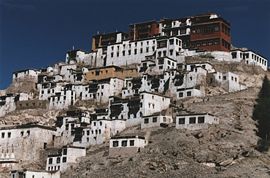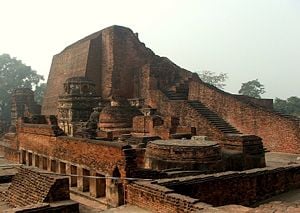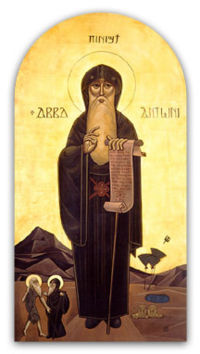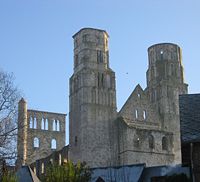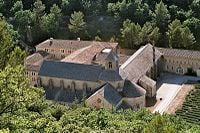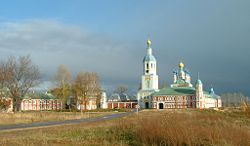Monastery
The term monastery (from Greek: μοναστήριον (monastērion) denotes the buildings of a community of monastics (monks or nuns).[1] Monasteries may vary greatly in size from a small dwelling accommodating only a hermit to vast complexes and estates housing thousands. In most religions, monasteries are governed by community rules that stipulate the gender of the inhabitants and require them to remain celibate and own little or no personal property. The degree to which life inside a particular monastery is socially separate from the surrounding populace can also vary widely; some religious traditions mandate isolation for purposes of contemplation removed from the everyday world, in which case members of the monastic community may spend most of their time isolated even from each other. Others are focused on interacting with the local communities in order to provide some service, such as teaching, medical care, or evangelism. Some monastic communties are only occupied seasonally, depending both on the traditions involved and the local weather, and people may be part of a monastic community for periods ranging from a few days at a time to almost an entire lifetime.
The life within the walls of a monastery may be supported in several ways: by manufacturing and selling goods, often agricultural products such as cheese, wine, beer, liquor, and jellies; by donations or alms; by rental or investment incomes; and by funds from other organizations within the religion which in the past has formed the traditional support of Monasteries. However, today Christian Monastics have updated and adapted themselves to modern society by offering computer services, accounting services, management as well as modern hospital administration in addition to running schools, colleges and universities.
Etymology
The word monastery comes from the Greek μοναστήριον "monasterion," from the root "monos" = alone (originally all Christian monks were hermits), and the suffix "-terion" = place for doing something. The earliest extant use of the term monastērion is by the first century CE Jewish philosopher Philo (On The Contemplative Life, ch. III).
Terminology
A monastery may be an abbey (i.e., under the rule of an abbot), or a priory (under the rule of a prior), or conceivably a hermitage (the dwelling of a hermit). It may be a community of men (monks) or of women (nuns). A charterhouse is any monastery belonging to the Carthusian order. In Eastern Christianity a very small monastic community can be called a skete, and a very large or important monastery can be given the dignity of a lavra.
The communal life of a Christian monastery is called cenobitic, as opposed to the anchoretic (or anchoritic) life of an anchorite and the eremitic life of a hermit.
Buddhist monasteries are generally called vihara (Pali language). Viharas may be occupied by males or females. In Tibetan Buddhism, monasteries are often called gompa or lamaseries. The monks are sometimes (mistakenly) known as lamas.In Thailand, Laos and Cambodia, a monastery is called a wat.
Jains use the term vihara. In Hinduism monasteries are called matha, mandir or koil.
History
The history of monasticism predates Christianity by a considerable period of time. When the first Christian cenobites banded together in the desert in the 4th century C.E., Buddhist monasteries had been in existence for seven hundred years or more, and had spread deep into the Persian empire. Scholar Robert Thurman suggests that "It is quite likely that (Buddhist monasticism) influenced West Asia, North Africa, and Europe through lending its institutional style to Manicheism and Aramaic and Egyptian Christianity."[1]
Buddhist monasteries were known as vihara and emerged sometime around the fourth century B.C.E., from the practice of vassa, the retreat undertaken by Buddhist monks and nuns during the South Asian rainy season. In order to prevent wandering monks from disturbing new plant growth or becoming stranded in inclement weather, Buddhist monks and nuns were instructed to remain in a fixed location for the roughly three month period typically beginning in mid-July. Outside of the vassa period, monks and nuns both lived a migratory existence, wandering from town to town begging for food. These early fixed vassa retreats were held in pavilions and parks that had been donated to the sangha by wealthy supporters. Over the years, the custom of staying on property held in common by the sangha as a whole during the vassa retreat evolved into a more cenobitic lifestyle, in which monks and nuns resided year round in monasteries.
In the Near East, famous monastic communities were the Essenes in Judea and the Therapeutae in Egypt.[2]The earliest known Christian monastic communities consisted of groups of cells or huts collected about a common centre, which was usually the house of some hermit or anchorite famous for holiness or singular asceticism, but without any attempt at orderly arrangement. Such communities followed the precedents already established in the region. Eventually, organization was introduced in the groups of huts. They were arranged in lines like the tents in an encampment, or the houses in a street. From this arrangement these lines of single cells came to be known as Laurae, Laurai, "streets" or "lanes."
In the earliest age of Christian monasticism the ascetics were accustomed to live singly, independent of one another, not far from some village church, supporting themselves by the labour of their own hands, and distributing the surplus after the supply of their own scanty wants to the poor. Increasing religious fervour, aided by persecution, drove them farther and farther away from the civilization into mountain solitudes or lonely deserts. The deserts of Egypt swarmed with the "cells" or huts of these anchorites. Anthony the Great, who had retired to the Egyptian desert during the persecution of Maximian, 312 C.E., was the most celebrated among these monks for his austerities, sanctity, and power as an exorcist. His fame resulted in many followers collecting around him who imitating his asceticism in an attempt to imitate his sanctity. The deeper he withdrew into the wilderness, the more numerous his disciples became. They refused to be separated from him, and built their cells round that of their spiritual father. Thus arose the first monastic community, consisting of monks living each in his own little dwelling, united together under one superior. Anthony, as Johann August Wilhelm Neander remarks,[3] "without any conscious design of his own, had become the founder of a new mode of living in common, Coenobitism."
The real founder of cenobitic (koinos, common, and bios, life) monasteries in the modern sense was Saint Pachomius, an Egyptian living in the beginning of the 4th century. The first community established by him was at Tabennae, an island of the Nile in Upper Egypt. Eight others were founded in the region during his lifetime, numbering 3,000 monks. Within fifty years of his death his societies could claim 50,000 members. These coenobia resembled villages, peopled by a hard-working religious community, all of one sex.
The buildings were detached, small and of the humblest character. Each cell or hut, according to Sozomen (H.R. iii. 14), contained three monks. They took their chief meal in a common refectory or dining hall at 3 P.M., up to which hour they usually fasted. They ate in silence, with hoods so drawn over their faces that they could see nothing but what was on the table before them. The monks spent any time not devoted to religious services or study in manual labour.
Palladius, who visited the Egyptian monasteries about the close of the 4th century, found among the 300 members of the coenobium of Panopolis, under the Pachomian rule, 15 tailors, 7 smiths, 4 carpenters, 12 camel drivers and 15 tanners. Each separate community had its own steward, who was subject to a chief steward stationed at the head establishment. All the produce of the monks' labour was committed to him, and by him shipped to Alexandria. The money raised by the sale was expended in the purchase of stores for the support of the communities, and what was over was devoted to charity. Twice in the year the superiors of the several coenobia met at the chief monastery, under the presidency of an archimandrite ("the chief of the fold," from miandra, a sheepfold), and at the last meeting gave in reports of their administration for the year. The coenobia of Syria belonged to the Pachomian institution. Many details concerning those in the vicinity of Antioch derive from Saint John Chrysostom's writings. The monks lived in separate huts, kalbbia, forming a religious hamlet on the mountain side. They were subject to an abbot, and observed a common rule. (They had no refectory, but ate their common meal, of bread and water only, when the day's labour was over, reclining on strewn grass, sometimes out of doors.) Four times in the day they joined in prayers and psalms.
The necessity for defence from hostile attacks (for monastic houses tended to accumulate rich gifts), economy of space and convenience of access from one part of the community to another, by degrees dictated a more compact and orderly arrangement of the buildings of a monastic coenobium. Large piles of building were erected, with strong outside walls, capable of resisting the assaults of an enemy, within which all the necessary edifices were ranged round one or more open courts, usually surrounded with cloisters. The usual Eastern arrangement is exemplified in the plan of the convent of the Holy Laura, Mount Athos.
Monasticism in the West owes its extension and development to Saint Benedict of Nursia (born 480 C.E.). His rule was diffused with miraculous rapidity from the original Benedictine monastery at Monte Cassino through the whole of Western Europe, and every country witnessed the erection of monasteries far exceeding anything that had yet been seen in spaciousness and splendour. Few great towns in Italy were without their Benedictine convent, and they quickly rose in all the great centres of population in England, France and Spain. The number of these monasteries founded between 520 C.E. and 700 is amazing. Before the Council of Constance, 1415 C.E., no fewer than 15,070 abbeys had been established of this order alone. The buildings of a Benedictine abbey were uniformly arranged after one plan, modified where necessary (as at Durham and Worcester, where the monasteries stand close to the steep bank of a river) to accommodate the arrangement to local circumstances.
We have no existing examples of the earlier monasteries of the Benedictine order. They have all yielded to the ravages of time and the violence of man. However, we have preserved to us an elaborate plan of the great Swiss monastery of St Gall, erected about 820 C.E., which puts us in possession of the whole arrangements of a monastery of the first class towards the early part of the 9th century. Benedictine rule enjoined that, if possible, the monastery should contain within itself every necessary of life, as well as the buildings more intimately connected with the religious and social life of its monks. It should comprise a mill, a bakehouse, stables, and cow-houses, together with accommodation for carrying on all necessary mechanical arts within the walls, so as to obviate the necessity of the monks going outside its limits.
The history of Christian monasteries is one of alternate periods of decay and revival. With growth in popular esteem came increase in material wealth, leading to luxury and worldliness. The first religious ardour cooled, the strictness of the rule was relaxed, until by the 10th century the decay of discipline was so complete in France that the monks are said to have been frequently unacquainted with the rule of St Benedict, and even ignorant that they were bound by any rule at all.
The reformation of abuses generally took the form of the establishment of new monastic orders, with new and more stringent rules, requiring a modification of the architectural arrangements. One of the earliest of these reformed orders was the Cluniac. This order took its name from the little village of Cluny, 12 miles N.W. of Macon, near which, about 909 C.E., a reformed Benedictine abbey was founded by William, duke of Aquitaine and count of Auvergne, under Berno, abbot of Beaume. He was succeeded by Odo, who is often regarded as the founder of the order. The fame of Cluny spread far and wide. Its rigid rule was adopted by a vast number of the old Benedictine abbeys, who placed themselves in affiliation to the mother society, while new foundations sprang up in large numbers, all owing allegiance to the "archabbot," established at Cluny.
By the end of the 12th century the number of monasteries affiliated to Cluny in the various countries of western Europe amounted to 2000. The monastic establishment of Cluny was one of the most extensive and magnificent in France. We may form some idea of its enormous dimensions from the fact recorded, that when, in 1245 C.E., Pope Innocent IV, accompanied by twelve cardinals, a patriarch, three archbishops, the two generals of the Carthusians and Cistercians, the king (St Louis), and three of his sons, the Queen mother, Baldwin, count of Flanders and emperor of Constantinople, the duke of Burgundy, and six lords, visited the abbey, the whole party, with their attendants, were lodged within the monastery without disarranging the monks, 400 in number. Nearly the whole of the abbey buildings, including the magnificent church, were swept away at the close of the 18th century. When the annexed ground-plan was taken, shortly before its destruction, nearly all the monastery, with the exception of the church, had been rebuilt.
The first English house of the Cluniac order was that of Lewes, founded by the earl of Warren, c. 1077 C.E. All Cluniac houses in England were French colonies, governed by priors of that nation. They did not secure their independence nor become "abbeys" till the reign of Henry VI. The Cluniac revival, with all its brilliancy, was but short-lived. The celebrity of this, as of other orders, worked its moral ruin. With their growth in wealth and dignity the Cluniac foundations became as worldly in life and as relaxed in discipline as their predecessors, and a fresh reform was needed.
The next great monastic revival, the Cistercian, arising in the last years of the 11th century, had a wider diffusion, and a longer existence. Owing its real origin as a distinct foundation of reformed Benedictines to Stephen Harding (a native of Dorset, educated in the monastery of Sherborne), in the year 1098, it derives its name from Citeaux (Cistercium), a desolate and almost inaccessible forest solitude, on the borders of Champagne and Burgundy. The rapid growth and wide celebrity of the order are undoubtedly to be attributed to the enthusiastic piety of St Bernard, abbot of the first of the monastic colonies, subsequently sent forth in such quick succession by the first Cistercian houses, the far-famed abbey of Clairvaux (de Clara Valle), 1116 C.E.
The rigid self-abnegation, which was the ruling principle of this reformed congregation of the Benedictine order, extended itself to the churches and other buildings erected by them. The characteristic of the Cistercian abbeys was the extremest simplicity and a studied plainness. Only one tower—a central one—was permitted, and that was to be very low. Unnecessary pinnacles and turrets were prohibited. The triforium was omitted. The windows were to be plain and undivided, and it was forbidden to decorate them with stained glass. All needless ornament was proscribed. The crosses must be of wood; the candlesticks of iron. The renunciation of the world was to be evidenced in all that met the eye.
The same spirit manifested itself in the choice of the sites of their monasteries. The more dismal, the more savage, the more hopeless a spot appeared, the more did it please their rigid mood. Yet they came not merely as ascetics, but as improvers. The Cistercian monasteries are, as a rule, found placed in deep well-watered valleys. They always stand on the border of a stream; not rarely, as at Fountains, the buildings extend over it. These valleys, now so rich and productive, wore a very different aspect when the brethren first chose them as the place of their retirement. Wide swamps, deep morasses, tangled thickets, wild impassable forests, were their prevailing features. The "bright valley," Clara Vallis of St Bernard, was known as the "valley of Wormwood," infamous as a den of robbers. "It was a savage dreary solitude, so utterly barren that at first Bernard and his companions were reduced to live on beech leaves."-(Milman's Lat. Christ. vol. iii. p. 335.)
Overall, European monasteries were the important centers of learning and literacy during the Middle Ages, which played key roles in the preservation of morality, culture and law. This practice remained when many monasteries became universities after the first millennium, and can still be seen at Oxford University and Cambridge University.
Cross-cultural Examples
Buddhist monasteries
In India, Buddhist monasteries gradually developed into centers of learning where philosophical principles were developed and debated; this tradition is currently preserved by monastic universities of Vajrayana Buddhists, as well as religious schools and universities founded by religious orders across the Buddhist world. In modern times, living a settled life in a monastery setting has become the most common lifestyle for Buddhist monks and nuns across the globe.
Whereas early monasteries are considered to have been held in common by the entire sangha, in later years this tradition diverged in a number of countries. Despite vinaya prohibitions on possessing wealth, many monasteries became large land owners, much like monasteries in medieval Christian Europe. In China, peasant families worked monastic-owned land in exchange for paying a portion of their yearly crop to the resident monks in the monastery, just as they would to a feudal landlord. In Sri Lanka and Tibet, the ownership of a monastery often became vested in a single monk, who would often keep the property within the family by passing it on to a nephew who ordained as a monk. In Japan, where civil authorities required Buddhist monks to marry, being the head of a temple or monastery sometimes became a hereditary position, passed from father to son over many generations.
Forest monasteries – most commonly found in the Theravada traditions of Southeast Asia and Sri Lanka – are monasteries dedicated primarily to the study of Buddhist meditation, rather than scholarship or ceremonial duties. Forest monasteries often function like early Christian monasteries, with small groups of monks living an essentially hermit-like life gathered loosely around a respected elder teacher. While the wandering lifestyle practiced by the Buddha and his disciples continues to be the ideal model for forest tradition monks in Thailand and elsewhere, practical concerns- including shrinking wilderness areas, lack of access to lay supporters, dangerous wildlife, and dangerous border conflicts- dictate that more and more 'meditation' monks live in monasteries, rather than wandering.
Some famous Buddhist monasteries include:
Christian monasteries
Traditionally, it is often said Christian monasticism started in Egypt. However, St. John the Baptist maybe said to have been the first Christian monk, albeit he was Jewish in a time when Christianity and Hebrewism were one and the same. After Saint Anthony founded his group the practice later continued on into Abyssinia (Ethiopia). According to tradition, in the third century St. Anthony was the first Christian to adopt this lifestyle. After a short while others followed. Originally, all Christian monks were hermits seldom encountering other people. But because of the extreme difficulty of the solitary life, many monks following Saint Amun, lived together and worship together under the same roof (Coenobitic Monasticism). Soon the Egyptian desert blossomed with monasteries, especially around Nitria, which was called the "Holy City.” Estimates are the upwards of 50,000 monks lived in this area at any one time.
Saint Eugenios founded a monastery on Mt. Izla above Nisibis in Mesopotamia (~350), and from this monastery the cenobitic tradition spread in Mesopotamia, Persia, Armenia, Georgia and even India and China.
Saint Saba organized the monks of the Judean Desert in a monastery close to Bethlehem (483), and this is considered the mother of all monasteries of the Eastern Orthodox churches.
St. Benedict of Nursia founded the monastery of Monte Cassino in Italy (529 C.E.), which was the seed of Roman Catholic monasticism in general, and of the order of Benedict in particular.
'La Grande Chartreuse' the mother house of the Carthusian Order founded by Saint Bruno of Cologne was established in the 11th century as an eremitic community.
Monasteries were important contributors to the surrounding community. They were centers of intellectual progression and education. They welcomed aspiring priests to come study and learn, allowing them even to challenge doctrine in dialogue with superiors. The earliest forms of musical notation are attributed to a monk named Notker of St Gall, and was spread to musicians throughout Europe by way of the interconnected monasteries. Since monasteries offered respite for weary pilgrim travelers, monks were obligated also to care for their injuries or emotional needs. Over time, lay people started to make pilgrimages to monasteries instead of just using them as a stop over. By this time, they had sizable libraries which were sort of a tourist attraction. Families would also donate a son in return for blessings. During the plagues, monks helped to till the fields and provide food for the sick.
In England the word monastery was also applied to the habitation of a bishop and the cathedral clergy who lived apart from the lay community. Most cathedrals were not monasteries, and were served by canons secular, which were communal but not monastic. However some were run by monastic orders, such as Cock Minster. Westminster Abbey was for a short time a cathedral, and was a Benedictine monastery until the Reformation, and its Chapter preserves elements of the Benedictine tradition.
Orthodox Christian monasteries
In the Eastern Orthodox Church, monks and nuns follow a similar ascetic discipline. Unlike Roman Catholics, there is only one form of monasticism for the Orthodox. Monastics, male or female, live lives away from the world, in order to pray for the world. They do not run hospitals and orphanages, they do not teach or care for the sick; it is expected for lay people to do these things to work out their own salvation. Monasteries can be very large or very small. The largest monasteries can hold many thousands of monks and are called lavras. Small monasteries are often called sketesand usually only have one elder and 2 or 3 disciples. There are higher levels to ascetic practice but the monks who practice these do not live in monasteries, but alone. When monks live together, work together, and pray together, following the directions of the abbot and the elder monks, this is called a cenobium. The idea behind this is when you put many men together, like rocks with sharp edges, their “sharpness” becomes worn away and they become smooth and polished.
One of the great centers of Orthodox monasticism is the Holy Mountain (also called Mt. Athos) in Greece, an isolated, self-governing peninsula approximately 20 miles long and 5 miles wide (similar to the Vatican, being a separate government), administered by the heads of the 20 major monasteries, and dotted with hundreds of smaller monasteries, sketes, and hesicaterons. Even today the population of the Holy Mountain numbers in the tens of thousands of monastics (men only) and cannot be visited except by men with special permission granted by both the Greek government and the government of the Holy Mountain itself.
A number of distinct monastic orders developed within Roman Catholicism including the following:
- Augustinian canons ('The Black Canons'), which evolved from the Priests Canon who would normally work with the Bishop: now living together with him as monks under St. Augustine's rule
- Benedictine monks ('The Black Monks'), founded by St. Benedict, stresses manual labor in a self-subsistent monastery. See Cluniac Reforms.
- Cistercian monks ('The White Monks') / *Trappist
- Camaldolese
- Bridgettine sisters
- Carthusian monks
- Gilbertine
- Poor Clare
- Byzantine Discalced Carmelites
- Premonstratensian canons ('The White Canons')
- Tironensian monks ('The Grey Monks')
- Valliscaulian monks
The last years of the 18th century marked in the Christian Church the beginnings of growth of monasticism among Protestant denominations. In the nineteenth century, monasticism was revived in the Church of England, leading to the foundation of such institutions as the House of the Resurrection, Mirfield (Community of the Resurrection), Nashdom Abbey (Benedictine), Cleeve Priory (Community of the Glorious Ascension) and Ewell Monastery (Cistercian), Benedictine orders, Franciscan orders and the Orders of the Holy Cross, Order of St. Helena. Other Prostestant Christian denominations also engage in Monasticism.
In the 1960s, expermental monastic groups were formed in which both men and women were members of the same house and also were permitted to be married and have children—these were operated on a communal form.
Hindu monasteries
In Hinduism, monks have existed for a long time, and with them, their respective monasteries, called mathas. Most famous among them are the chatur-amnaya mathas established by Adi Shankara, as well as Ashta matha (Eight monasteries) of Udupi founded by Madhvacharya a Dvaitaa philosopher.
Typical Organization
In the Middle Ages, Christian monasteries were organized in a general pattern, which included the following typical elements. A church, with its cloister to the south, occupies the centre of a quadrangular area, about 430 feet square. The buildings, as in all great monasteries, are distributed into groups. The church forms the nucleus, as the centre of the religious life of the community. In closest connection with the church is the group of buildings appropriated to the monastic line and its daily requirements---the refectory for eating, the dormitory for sleeping, the common room for social intercourse, the chapter-house for religious and disciplinary conference. These essential elements of monastic life are ranged about a cloister court, surrounded by a covered arcade, affording communication sheltered from the elements between the various buildings. The infirmary for sick monks, with the physician's house and physic garden, lies to the east. In the same group with the infirmary is the school for the novices. The outer school, with its headmaster's house against the opposite wall of the church, stands outside the convent enclosure, in close proximity to the abbot's house, that he might have a constant eye over them.
The buildings devoted to hospitality are divided into three groups,—one for the reception of distinguished guests, another for monks visiting the monastery, a third for poor travellers and pilgrims. The first and third are placed to the right and left of the common entrance of the monastery,---the hospitium for distinguished guests being placed on the north side of the church, not far from the abbot's house; that for the poor on the south side next to the farm buildings. The monks are lodged in a guest-house built against the north wall of the church. The group of buildings connected with the material wants of the establishment is placed to the south and west of the church, and is distinctly separated from the monastic buildings. The kitchen, buttery and offices are reached by a passage from the west end of the refectory, and are connected with the bakehouse and brewhouse, which are placed still farther away. The whole of the southern and western sides is devoted to workshops, stables and farm-buildings. The buildings, with some exceptions, seem to have been of one story only, and all but the church were probably erected of wood. The whole compound included thirty-three separate blocks.
Every large monastery had depending upon it smaller foundations known as cells or priories. Sometimes these foundations were no more than a single building serving as residence and farm offices, while other examples were miniature monasteries for five or ten monks. The outlying farming establishments belonging to the monastic foundations were known as villae or granges. They were usually staffed by lay-brothers, sometimes under the supervision of a single monk.
Westminster Abbey is an example of a great Benedictine abbey. The cloister and monastic buildings lie to the south side of the church. Parallel to the nave, on the south side of the cloister, was the refectory, with its lavatory at the door. On the eastern side we find the remains of the dormitory, raised on a vaulted substructure and communicating with the south transept. The chapter-house opens out of the same alley of the cloister. The small cloister lay to the south-east of the larger cloister, and still farther to the east we have the remains of the infirmary with the table hall, the refectory of those who were able to leave their chambers. The abbot's house formed a small courtyard at the west entrance, close to the inner gateway.
Considerable portions of Westminster Abbey remain, including the abbot's parlour, celebrated as "the Jerusalem Chamber," his hall, now used for the Westminster King's Scholars, and the kitchen and butteries beyond.
Recent trends
Modern Monasticsm in the Catholic Church and other Christian Denominations under went a Reformation beginning in 1948 lasting until the 1960s. The Reformation was lead by Fr. Thomas Merton, a Trappist Monk, whose Monastery was the Abbey of Gethsemani, in Trappist, Kentucky. Father Merton saw the Monastic as little more than a slave of the Church and its orders requiring Monastics to do break backing work with no pay other than the bare food they ate, clothing given them on their back. He sat about to reform the monk's life not only for Trappists but for other orders also instituting salaries and benefits commonly found in labor laws of the United States and other Countries. Father Merton, in addition to writing many books, continued these reforms until his death in 1968.
The number of dedicated monastics in any religion has waxed and waned due to many factors. There have been Christian monasteries such as "The Cappadocian Caves" that used to shelter upwards of 50,000 monks, or St Pantelaimon's on the "Mount Athos" in Greece, which had 30,000 in its heyday. Today those numbers have dwindled considerably. Currently the monasteries containing the largest numbers are Buddhist: Drepung Monastery in Tibet housed around 15,000 monks prior to the Chinese invasion. Today its relocated monastery in India houses around 8,000 - nearly five times the current monastic population of the entire Holy Mountain.
On the other hand, there are those among monastic leaders that are critical of monasteries that are too large. Such become institutions and lose that intensity of spiritual training that can better be handled when an elder has only two or three disciples. There are on the Holy Mountain areas such as the Skete of St Anne, which could be considered one entity but is in fact many small "Sketes" (monastic houses containing one elder and two or three disciples) who come together in one church for services.
Additionally, there is Christian neo-monasticism growing, particularly among evangelical Christians. Established upon at least some of the customary monastic principles, they have attracted many who seek to live in relationship with other, or who seek to live in an intentionally-focused lifestyle, such as a focus upon simplicity or pacifism. Some include rites, novitiate-periods which a newly interested person can test out living, sharing of resources, while others are more pragmatic, providing a sense of family in addition to a place to live.
Notes
- ↑ In Christianity, the term convent tends to be used for buildings accommodating female monastics rather than monastery; the term nunnery for the latter is outmoded.
- ↑ Simon, Marcel and James H. Farley (tr.) Jewish Sects at the Time of Jesus. (Philadelphia: Fortress Press, 1980); Taylor, Joan E. Jewish Women Philosophers of First-Century Alexandria: Philo's "Therapeutae" Reconsidered. (Oxford University Press, 2006); Taylor, Joan E. and Philip R. Davies "The So-Called Therapeutae of "De Vita Contemplativa": Identity and Character." The Harvard Theological Review. Vol. 91, No. 1 (Jan., 1998), pp. 3-24
- ↑ In Church History, iii. p. 316, Clark's translation.
ReferencesISBN links support NWE through referral fees
- Chandramouli, N.S. "Did Buddhism influence early Christianity?" The Times of India. May 1, 1997.
- Eusebius and Paul L. Maier (tr.) Eusebius: The Church History Kregel Academic & Professional, 2007. ISBN 978-0825433078
- Gruber, Elmar R. and Holger Kersten. "The Original Jesus: The Buddhist Sources of Christianity." Element Books, Shaftesbury, 1996. ISBN 978-1852308353
- Mitra, D. (1971). Buddhist Monuments. Sahitya Samsad: Calcutta. ISBN 0-89684-490-0
- Simon, Marcel and James H. Farley (tr.) Jewish Sects at the Time of Jesus Philadelphia: Fortress Press, 1980. ISBN 978-0800601836
- Tadgell, C. (1990). The History of Architecture in India. Phaidon: London. ISBN 1-85454-350-4.
- Taylor, Joan E. and Philip R. Davies "The So-Called Therapeutae of "De Vita Contemplativa": Identity and Character." The Harvard Theological Review. Vol. 91, No. 1 (Jan., 1998), pp. 3-24
External links
All links retrieved November 1, 2007.
- Monastery and Abbeys of Provence in France
- Christian Monasteries and Abbeys
- Links to Coptic Orthodox Monasteries of Egypt and the world
- Byzantine Ruthenian Discalced Carmelite Monastery
Credits
New World Encyclopedia writers and editors rewrote and completed the Wikipedia article in accordance with New World Encyclopedia standards. This article abides by terms of the Creative Commons CC-by-sa 3.0 License (CC-by-sa), which may be used and disseminated with proper attribution. Credit is due under the terms of this license that can reference both the New World Encyclopedia contributors and the selfless volunteer contributors of the Wikimedia Foundation. To cite this article click here for a list of acceptable citing formats.The history of earlier contributions by wikipedians is accessible to researchers here:
The history of this article since it was imported to New World Encyclopedia:
Note: Some restrictions may apply to use of individual images which are separately licensed.
